When Were Binoculars Invented: 10 Things You Didn’t Know
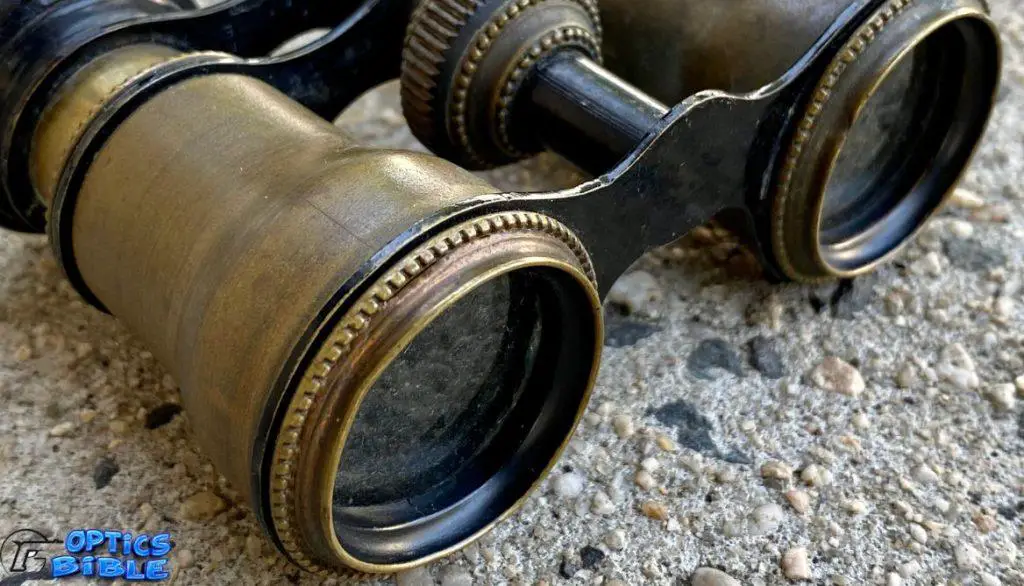
Over the past several decades, there has been a dramatic increase in the advancement and common usage of the modern prism binocular. But, have you ever thought to ask the question, when were binoculars invented? This remains the top ask when talking about binoculars.
Hans Lipperhey from the early 1600s is credited with having invented binoculars. His famous telescope device set the stage for advancement in this field for the people around the world.
In this article, you will learn about what are binocular, theirinvention,and their common application of them. So, let’s find out without any further thoughts!
What are Binoculars?
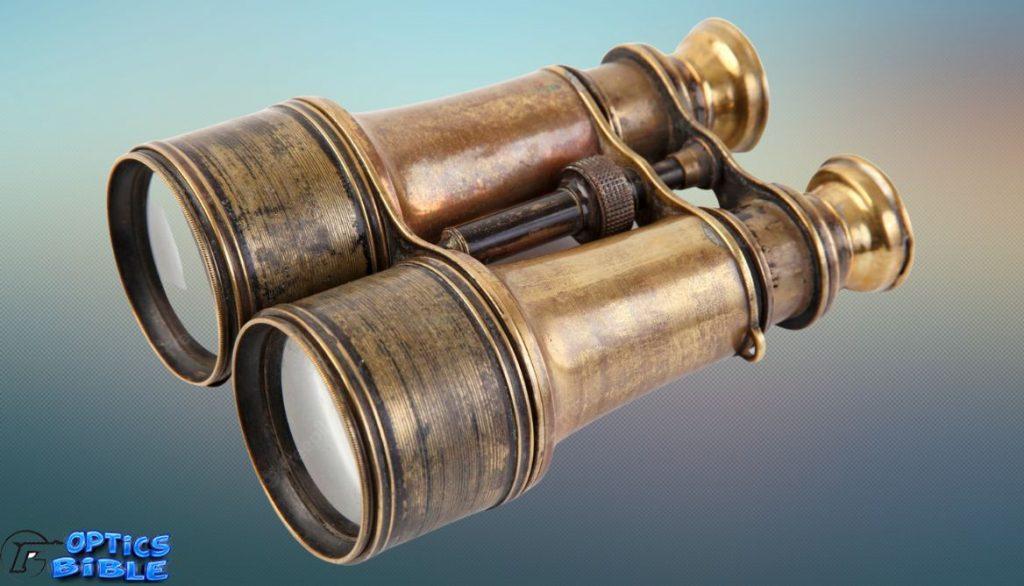
Binoculars are optical instruments that are used to magnify objects that are far away. Binoculars are made up of two scopes attached on either side and aligned to focus in the same direction.
Being able to magnify objects that are millions of miles away has been nothing short of a miracle for the human species. The working principle of binoculars is based on the science of optics and light.
Common Uses of Binoculars
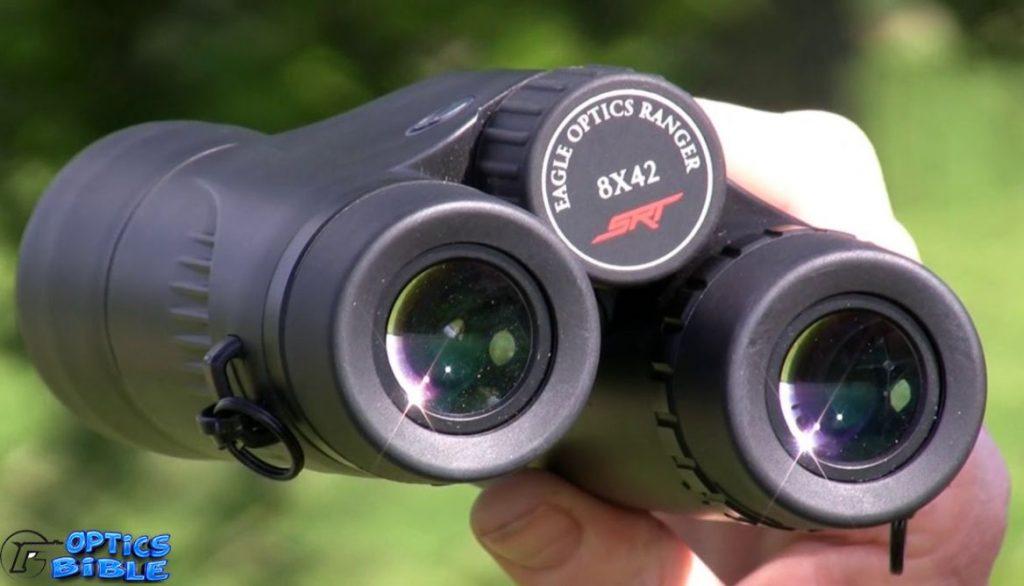
A binocular is a device that comes handy basically when viewing distant objects such as when watching your favorite games while at the rear, hiking, wildlife viewing, birding, hunting, boating, stargazing with a binocular telescope, sports, theatre, and lots more.
Who Invented Binoculars?
So there is no single person “who invented binoculars.” Throughout history, many scholars, inventors, and other clever minds have made discoveries and inventions that have made modern binoculars possible.
The idea for a modern prism binocular began with the constant improvements in the earliest binocular version known to man. Let’s look at what it took to turn the first reading stones into modern hand-held glasses.
Ancient Rock Crystal Lenses
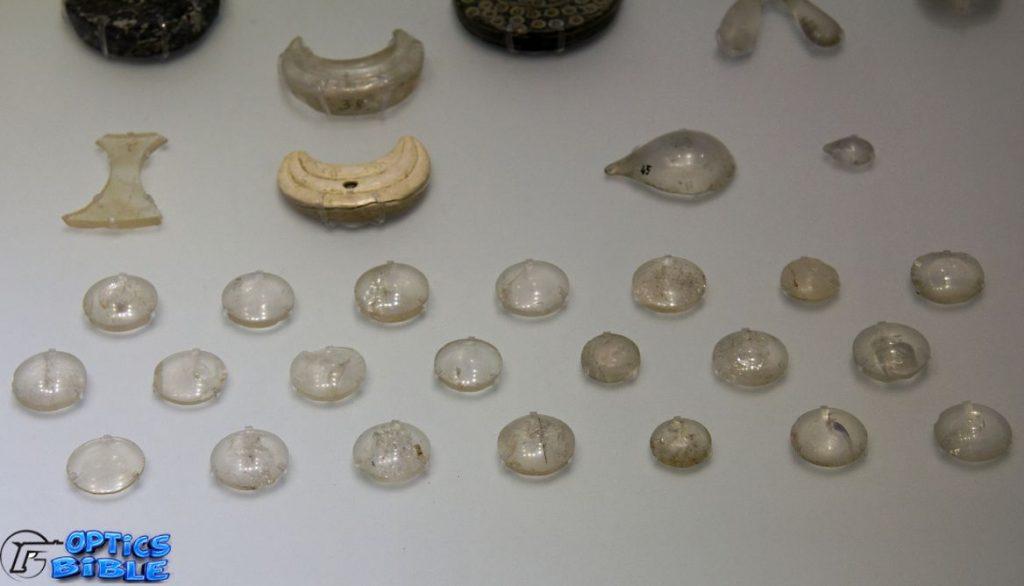
The oldest known rock crystal lenses is the Nimrud lens. It was found by Austen Henry Layard during excavations, in 1850, in a palace in the ancient city of Nimrud, which belongs to Iraq today.
Reading Stones

A reading stone is an approximately hemispherical lens that can be placed on top of the text to magnify the letters so that people with presbyopia can read them more easily. The invention of reading stones is often credited to Abbas ibn Firnas in the 9th century. A magnifying glass is a type of modern-day reading stone.
First Glass Lenses Used in Eyeglasses

It is difficult to say who really discovered the first glass lenses. Roger Bacon has done important preliminary work and many books give him credit for inventing the magnifying glass lenses.
From then on, progress was made quickly. Glass lenses were made in Venice as early as the 13th century. Many old frescoes and paintings from the 14th century show monks and scholars wearing glasses.
When Were Binoculars Invented?
Well, it’s a long story: over 2000 years ago, ancient scholars started to study optics and the theory of light, its propagation, the laws of light refraction, and its application on single curved mirrors, reflecting mirrors, reflecting telescopes, and the very first telescope design.
However, it took until 1608 until all of this knowledge was put into practice and the first usable optical instrument was discovered, with which one could enlarge distant objects so that they appeared to be much closer to the observer than they really were.
Hans Lipperhey
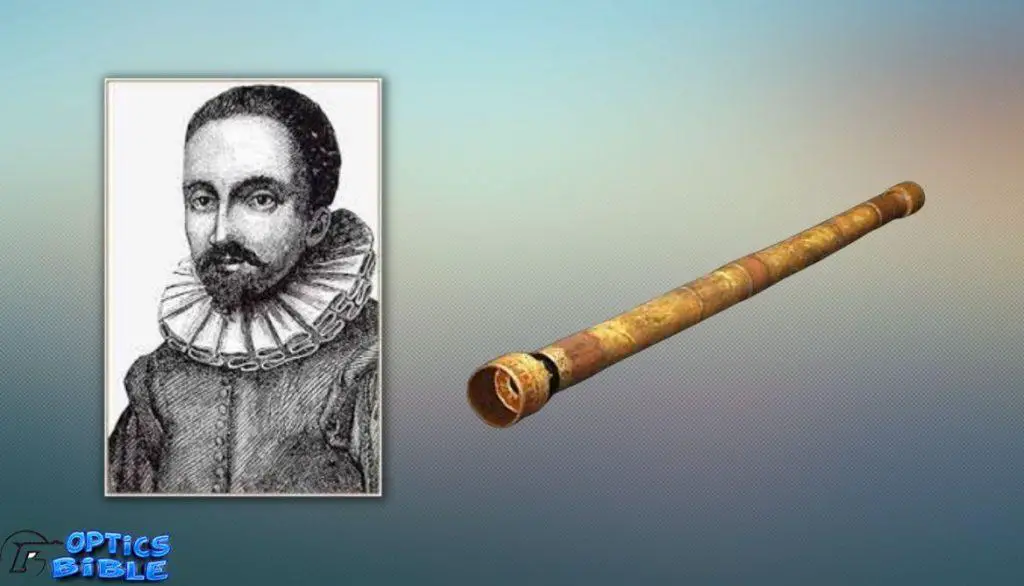
In early 1608, the Dutch lens grinder and spectacle maker Hans Lipperhey experimented with optical lenses.
His research intothe curved mirror and optical lenses led to finding out that when a convex lens and a concave lens were arranged in a certain way along an optical axis, distant objects are shown enlarged as if they were near.
He is considered to have invented the first telescope and the first lenses. Thus many refer to him as the inventor of early binoculars due to his pioneering work with curved mirror and optical lenses.
Galileo Galilei
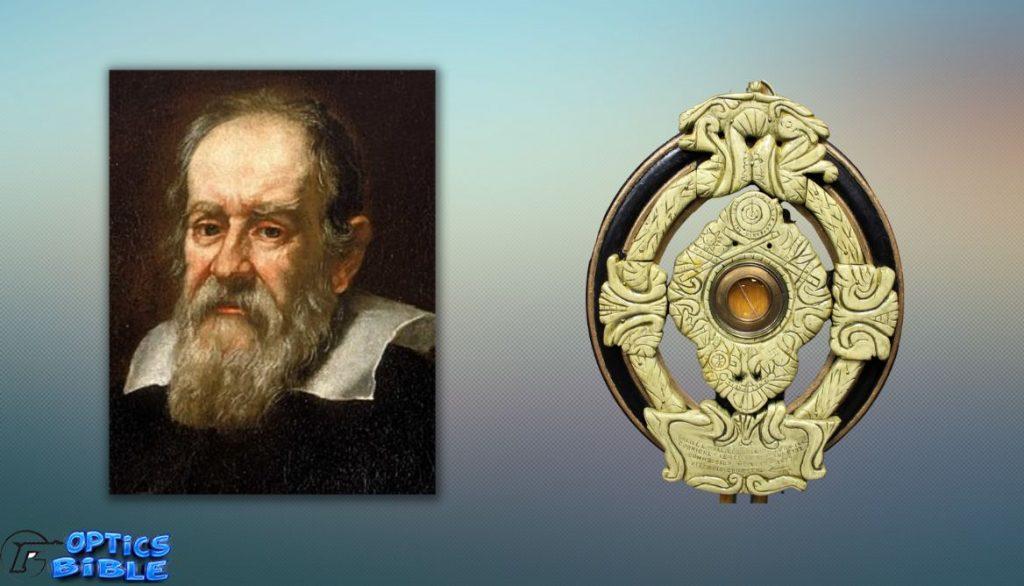
The Italian astronomer, physicist, and engineer, Galileo Galilei, took on Lipperhey’s idea and constructed such a device widely comparable to the Galileo’s telescope but offered the simplest construction consisting of only one concave lens and one convex lens.
Galileo’s telescope was used to look at celestial objects and changed the world with his discoveries in the astronomical field. He was the first man to see the craters on the moon and went on to discover sunspots, the four large moons of Jupiter, and the rings of Saturn.
Johannes Keppler
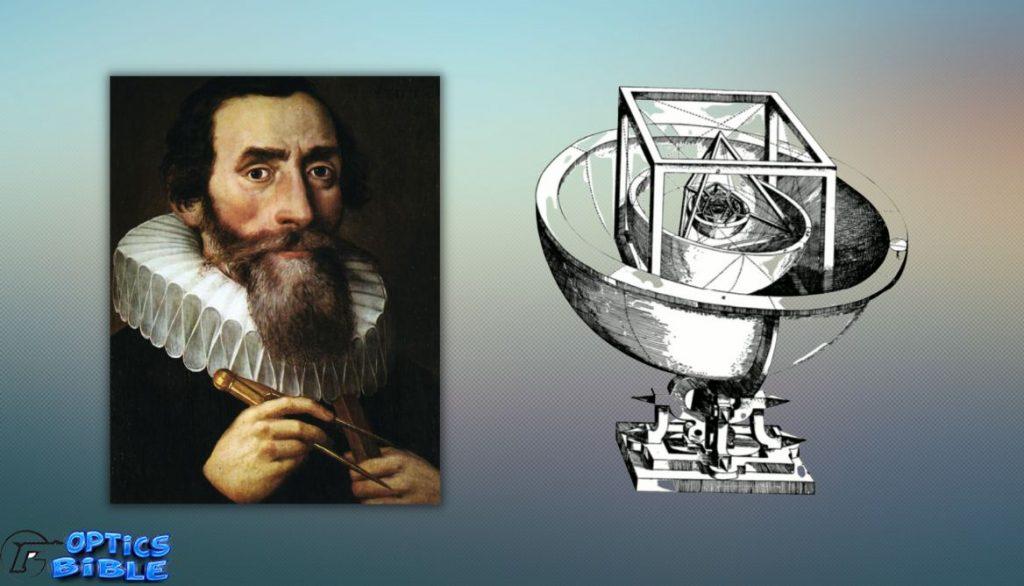
A little later, in 1611, Johann Kepler, the great astronomer, invented a new telescope construction, the Keplerian telescope. It used a convex lens as an eyepiece instead of the concave lens used in Galilean telescope binoculars. The field of view was much wider than with the Galileo telescope.
Erecting lenses
In a prismatic binoculars with Keplerian optics (which were sometimes called “twin telescopes”), each tube has one or two additional lenses between the objective and the eyepiece. These lenses are used to erect the image.
The binoculars with erecting lenses had a serious disadvantage: they are too long. Such binoculars were popular in the 1800s.
The Keplerian “twin telescopes” binoculars were optically and mechanically hard to manufacture, but it took until the 1890s to supersede them with better prism-based technology.
Modern Porro Prism binoculars
Optical prisms added to the design enabled the display of the image the right way up without needing as many lenses and decreased the overall length of the instrument, typically using Porro prism or roof prism systems.
Porro
Porro prism binoculars are named after Ignazio Porro, who patented this image prism erecting system in 1854.
Binoculars of this type use a pair of Porro prisms in a Z-shaped configuration to erect the image and offer a better image quality. They have objective lenses that are well separated and offset from the eyepieces, giving a better sensation of depth.
These binoculars had a prism erecting system that erected an image in a relatively small space. Ernst Abbe along with Otto Schott and Carl Zeiss introduced the improved modern porro prism binoculars for commercial purposes through the Carl Zeiss company.
Roof
Roofprismbinoculars may have appeared as early as the 1870s in a design by Achille Victor Emile Daubresse. Out of the invented binoculars with a roof prism, most use either the Schmidt–Pechan prism (invented in 1899) or the Abbe–Koenig prism designs to erect the image and fold the optical path.
Roof prism designs result in objective lenses that are almost or totally in line with the eyepieces, creating an instrument that is narrower and more compact and more light than the older prismatic design.
Porro prism and Abbe–Koenig roof binocularswill inherently produce a brighter image than the Schmidt–Pechan roof prism of the same magnification, objective size, and optical quality.
Johann Friedrich Voigtländer
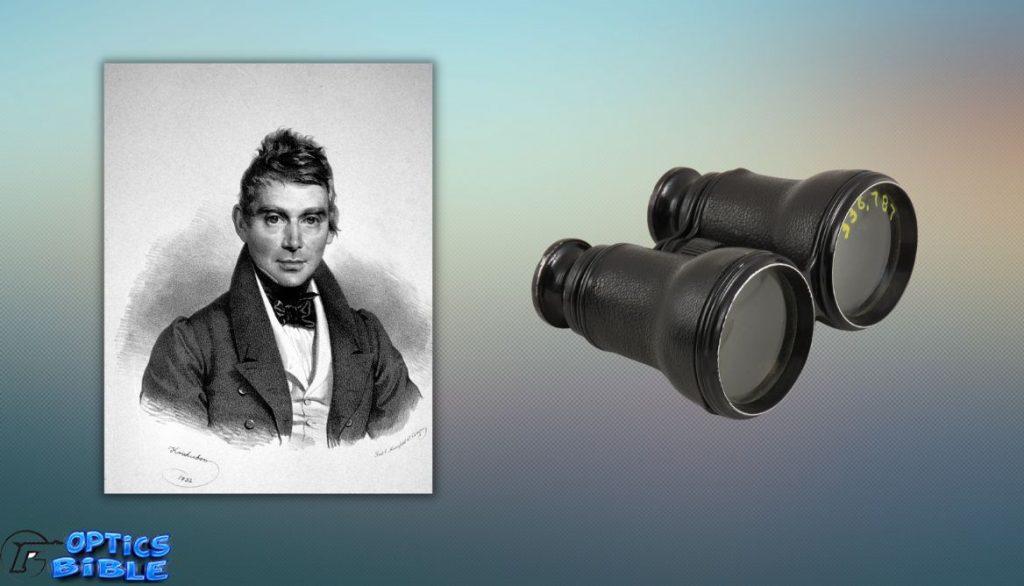
The Austrian optician named Johann Friedrich Voigtländer was one of the first who invented binoculars in 1823 that had a practical use.
He simply aligned two small prismatic telescopes parallel to each other so that the user could look through each telescope tube of the similar telescopes at the same time and build the opera glass.
These simple binoculars did not yet have prisms butt they offered a narrow field of view, and had only marginal magnification, but these were very simple forms of the binoculars principle known.
Ignazio Porro

The Italian engineer and inventor Ignazio Porro is the inventor of the Porro prism that is used in prism telescope, monoculars, binoculars, and stereomicroscopes.
The Porro prism, which was patented in 1854, made it possible to reverse the 180-degree reversal of the image projected in the Keplerian reflector telescope so that the viewer sees an image that corresponds to reality.
For this, he used two half-cube prisms, which were placed at 90 degrees to each other. Ignazio Porro built a monocular that, with the reversing effect of the Porro prism, provided the observer with upright correct images.
Moritz Hensoldt
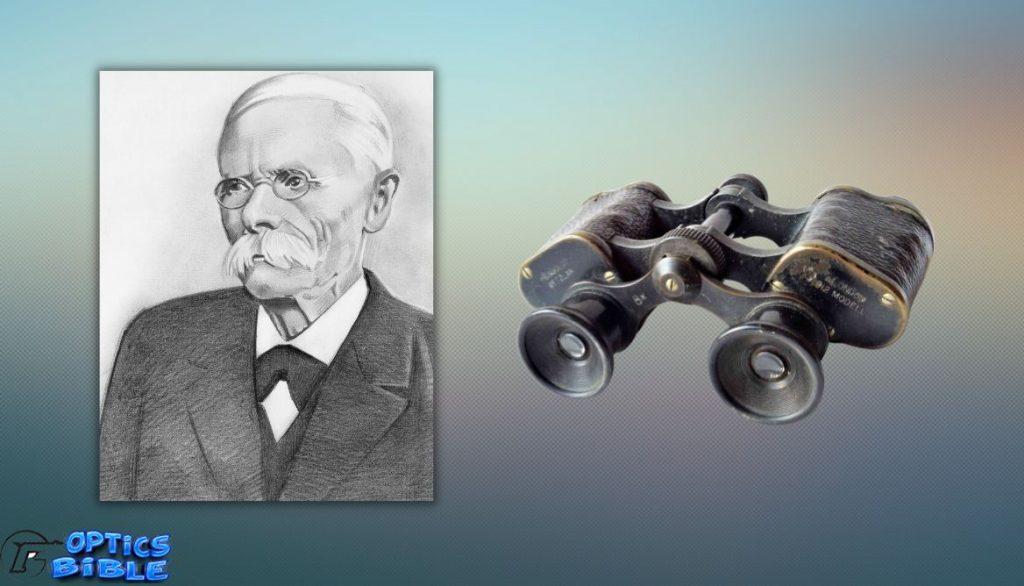
Moritz Carl Hensoldt a German inventor and co-founder of an optical and precision engineering company in Wetzlar experimented in 1892 and 1893 with image-inverting prism combinations, and how to improve the well-known opera glasses with them.
A couple of years later, Hensoldt presented the first binoculars with five-sided roof prisms the Penta 7×29, Model A was able to provide the user with so-called “standing images”, images as we see them today when looking through prism binoculars.
Carl Zeiss
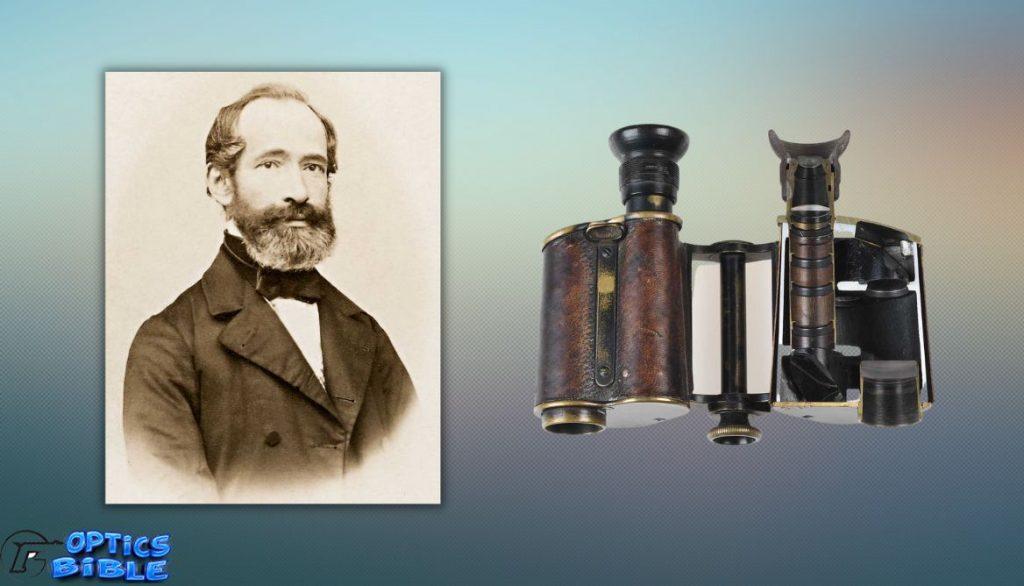
Carl Zeiss was a German scientific instrument maker, optician, and businessman who founded the Carl Zeiss workshop in Jena in 1846. The company is still in operation today as Carl Zeiss AG, they are world leaders in making quality optical instruments.
Zeiss gathered some of the best engineering and theoretical opticians and curved mirror glassmakers to redesign most aspects of optical instrument manufacturing.
They continued to research optical glass and discovered glass with new and improved optical properties. His collaboration with Ernst Abbe revolutionized the optical theory and practical design of binoculars and microscopes
Optical parameters
The following are the important parameters of a binocular:
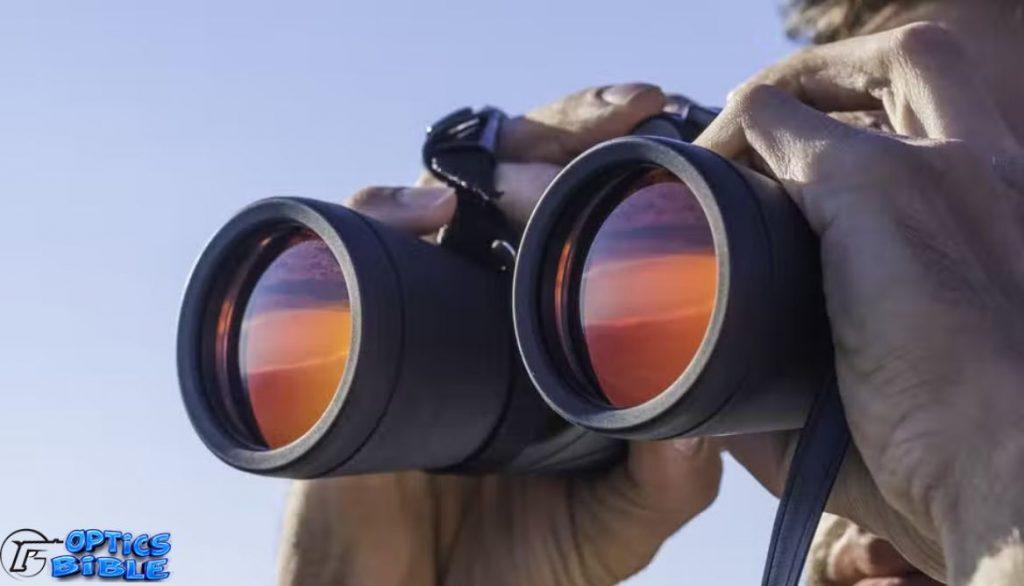
Magnification
Magnification is the ratio of the objective’s focal length divided by the eyepiece’s focal length. The desirable amount of magnification depends upon the intended application and in most binoculars, is a permanent, non-adjustable feature of the device (zoom binoculars are the exception).
Objective Diameter
The diameter of the objective lens determines the resolution (sharpness) and how much light remained can be gathered to form an image.
Field of View
The field of view of a pair of binoculars depends on its optical design and in general is inversely proportional to the magnifying power.
Exit Pupil
Binoculars concentrate the light gathered by the objective into a beam, of which its diameter, the exit pupil, is the objective diameter divided by the magnifying power.
Twilight Factor and Relative Brightness
The twilight factor for binoculars can be calculated by first multiplying the magnification by the objective lens diameter and then finding the square root of the result. A primarily historic mathematical approach to indicate the level of clarity and brightness in binoculars was relative brightness.
Eye Relief
Eye relief is the distance from the rear eyepiece lens to the exit pupil or eye point. It is the distance the observer must position his or her eye behind the eyepiece in order to see a non-vignetted image.
Close Focus Distance
Close focus distance is the closest point of focus. If the close focus distance is short with respect to the magnification, the binocular can be used also to see particulars not visible to the naked eye. Keeping point of focus in mind when looking for a binoculars is important.
Eyepieces
Binocular eyepieces usually consist of three or more lens elements in two or more groups. The lens furthest from the viewer’s eye is called the field lens or objective lens and that closest to the eye the eye lens or ocular lens.
Field flattener lens
High-end binoculars incorporate a field flattener lens in the eyepiece behind the prism configuration. It is used to improve image sharpness and reduce image distortion at the outer regions of the field of view.
Mechanical Design
The accuracy, enhancing utility, and upgrading the target acquisition are some of the main advantages that come with a mechanical design. Let us review some important aspects of a mechanical design:

Focus and Adjustment
Binoculars have a focusing arrangement which changes the distance between eyepiece and objective lenses or internally mounted lens elements. Normally there are two different arrangements used to provide focus, “independent focus” and “central focusing”:
Interpupillary Distance
Interpupillary distance (IPD) is the distance measured in millimeters between the centers of the pupils of the eyes.
Alignment
Alignment is moving the prisms, by adjusting an internal support cell or by turning external set screws, or by adjusting the position of the objective via eccentric rings built into the objective cell.
Image Stability
Image-stabilization technology is used to reduce the shaking at higher magnifications. This is done by having a gyroscope move part of the instrument to oppose and dampen the effect of shaking movements.
Housing
The optical elements, which are essential for the functioning of binoculars, are accommodated in the housing. Most occasional users don’t think twice about the binoculars’ housing as long as the instrument is working.
Optical coatings
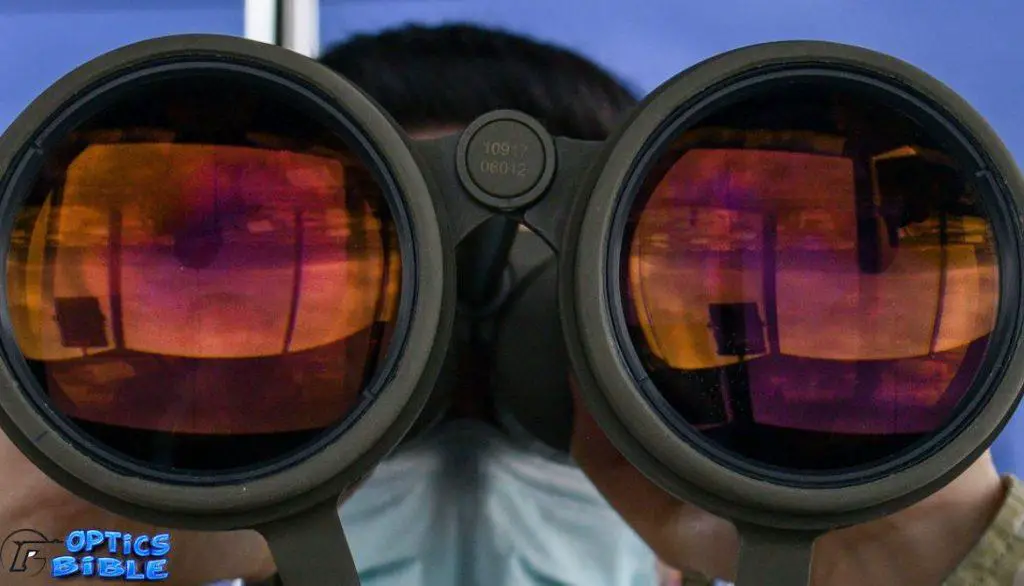
Binocular manufacturers use different types of optical coatings for technical reasons and to improve the image they produce.
Lens and prism optical coatings on binoculars can increase light transmission, minimize detrimental reflections and interference effects. The optical coatings also repel water, and even protect the lens from scratches.
Modern optical coatings are composed of a combination of very thin layers of materials such as oxides, metals, or rare earth materials.
Anti-reflective
Anti-reflective interference coatings reduce light lost by the reflecting mirror through reflection at each surface. Reducing reflection via anti-reflective coatings also reduces the amount of “lost” light present inside the binocular which would otherwise make the image appear hazy (low contrast).
Phase Correction
Phase-correction coatings are used across the board in medium and high-quality roof prism binoculars. This coating suppresses the difference in phase shift between s- and p- polarization so both paths have the same polarization and no interference degrades the image.
Metallic Mirror
Without a mirror coating, most of that light would be lost. To avoid this, the roof prisms use aluminum mirror coating or silver mirror coating which is sealed and filled with nitrogen or argon. This prevents the silver coating from tarnishing.
Dielectric Mirror
Dielectric coatings are used in Schmidt–Pechan and Uppendahl roof prisms to cause the prism surfaces to act as a dielectric mirror. This coating was introduced in 2004 in Zeiss Victory FL binoculars featuring Schmidt–Pechan prisms.
The non-metallic dielectric reflective coating is formed from several multilayers of alternating high and low refractive index materials deposited on a prism’s reflective surfaces.
Terms
Some technical terminologies are explained here to broaden your understanding of the different lens coatings and their speciality. Let us simplify the terms for better understanding:
All binoculars
The presence of any coatings is typically denoted on binoculars by the following terms:
- Coated optics: one or more surfaces are anti-reflective coated with a single-layer coating.
- Fully coated: all air-to-glass surfaces are anti-reflective coated with a single-layer coating. Plastic lenses, however, if used, may not be coated.
- Multi-coated: one or more surfaces have anti-reflective multi-layer coatings.
- Fully multi-coated: all air-to-glass surfaces are anti-reflective multi-layer coated.
Roof prisms only
- Phase-coated or P-coating: the roof prism has a phase-correcting coating
- Aluminium-coated: the roof prism mirrors are coated with an aluminium coating (the default if a mirror coating isn’t mentioned).
- Silver-coated: the roof prism mirrors are coated with a silver coating
- Dielectric-coated: the roof prism mirrors are coated with a dielectric coating
Accessories
Common accessories for binoculars are:
- Neck and shoulder straps for carrying
- Binocular harnesses to distribute weight evenly for prolonged carrying
- Field carrying cases/side bags
- Binoculars storage/travel cases
- Rain-guards for protecting the eyepieces outer lenses
- Lens caps for protecting the objectives outer lenses
- Cleaning kits to carefully remove dirt from lenses and other surfaces
- Tripod adapters
Applications
Following are some of the applications that shed light on different uses of binoculars.
General Use
Hand-held binoculars range from small 3 × 10 Galilean opera glasses, used in theaters, to glasses with 7 to 12 times magnified view and 30 to 50 mm diameter objectives for typical outdoor use.
Compact or pocket binoculars are small light binoculars suitable for daytime use. Many tourist attractions have installed pedestal-mounted, coin-operated binocular tower viewers to allow visitors to obtain a closer view of the attraction.
Land Surveys and Geographic Data Collection
Although technology has surpassed using binoculars for data collection, historically, these were advanced tools used by geographers and other geoscientists. Field glasses still today can provide a visual aid when surveying large areas.
Bird Watching
Birdwatching is a very popular hobby among nature and animal lovers. Binoculars are their most basic tool because most human eyes cannot resolve sufficient detail to fully appreciate and/or study small birds. The other main consideration for birdwatching binoculars is the size of the object that acts as a light-collecting bucket.
Hunting
Hunters commonly use binoculars in the field to observe distant animals and terrain. A good hunting binocular offers excellent low-light performance for more stationary hunting at dusk and night. They are built to be light-weight, keeping in mind the extended carrying/stalking and their mobile use.
Range Finding
Some binoculars have a range-finding reticle (scale) superimposed upon the view to distant objects. This scale allows the distance to the object to be estimated if the object’s height is known (or estimable).
Military Reflector Telescope
Binoculars have a long history of military use. Galilean telescope designs were widely used up to the end of the 19th century when they gave way to porro prism types.
Binoculars constructed for general military use tend avoid fragile center focusing mechanism arrangements in favor of independent focus, which also makes for easier, more effective weatherproofing.
Prism sets in military binoculars may have redundant aluminized coatings on their prism sets to guarantee they don’t lose their reflective qualities if they get wet.
Marine
There are binoculars designed specifically for civilian and military use under harsh environmental conditions at sea.
With an optical combination prevents the image vignetting or going dark when the binoculars are pitching and vibrating relative to the viewer’s eyes due to a vessel’s motion. Marine binoculars often contain one or more features to aid in navigation on ships and boats.
Astronomical
Binoculars specifically geared towards astronomical viewing will have larger aperture objectives because the diameter of the lens increases the total amount of light captured, and therefore determines the faintest star that can be observed.
.Binoculars designed specifically for astronomical viewing are sometimes designed without prisms in order to allow maximum light transmission. Such binoculars also usually have changeable eyepieces to vary magnification.
Modern Prism Binocular
Like all technical devices and inventions, binoculars are also subject to constant progress. When binoculars were invented they were initially quite small and compact and a scholar could put it in front of his window and look at the sky.
Modern prism binocular, as we know today is the result of the ideas and inventions of many clever minds in world history.
The James Webb Space Telescope is to-date the finest telescope design used by a special astrophysical observatory. It allows us to see farther than any binocular telescope and has brought us unimaginable insights and discoveries into the early universe.
List of Binocular Manufacturers
Given below is a list of a few companies that manufacture binoculars:
- Barr and Stroud
- Bausch & Lomb
- BELOMO
- Bresser
- Bushnell Corporation
- Blaser
- Canon Inc
- Celestron
- Docter Optics
- Fujinon
- I.O.R.
- Kazan Optical-Mechanical Plant
- Kowa
- Krasnogorsky Zavod
- Leica Camera
- Leupold & Stevens, Inc
- Meade Instruments
- Meopta
- Minox
- Nikon
- Olympus Corporation
- Pentax
- Sill Optics
- Steiner-Optik
- PRAKTICA
- Sunagor
- Swarovski Optik
- Takahashi Seisakusho
- Tasco
- Vixen
- Vivitar
- Vortex Optics
- Zeiss
FAQ
When did binoculars become common?
The modern configuration of the refracting terrestrial telescope was in place by perhaps the late 1600s but certainly by the mid-1700s.
Did binoculars exist in the 1800s?
It was not until the early 1800s that Galilean binoculars were produced. By the early 1700s, small Galilean telescope, usually called spyglasses, prospect glasses, or opera telescopes, had become common.
Who invented binoculars in 1608?
The binocular is an optical instrument consisting of two telescopes, one for each eye, mounted on a single frame. When Hans Lipperhey applied for the patent of his first binoculars in 1608, he was actually asked to build a binocular version. He reportedly did so late that year.
What are old binoculars called?
Binoculars were first invented in France in the 1840s. They started small, primarily as opera glasses, but by the Civil War were being used in battle. These larger versions became known as field glasses.
What did people use before binoculars?
Before the Galilean binoculars were produced in the 1800s, reflector telescope, usually called spyglass, prospect glasses, or opera telescopes, had become common. Initially, these handheld telescopes had a single draw and a small field of view.
Conclusion
The exciting history of modern binoculars portrays that binoculars have undergone drastic transformations over the centuries. Modern-day binoculars come in different shapes and sizes.
For anyone looking to buy a pair, we recommend that you consider three main factors: requirements, specifications, and total costs. Note that different units are suited to different fields of application.
What are the binocular types that you want to try? Share your opinion in the comment section below as we would love to hear your point of view!
